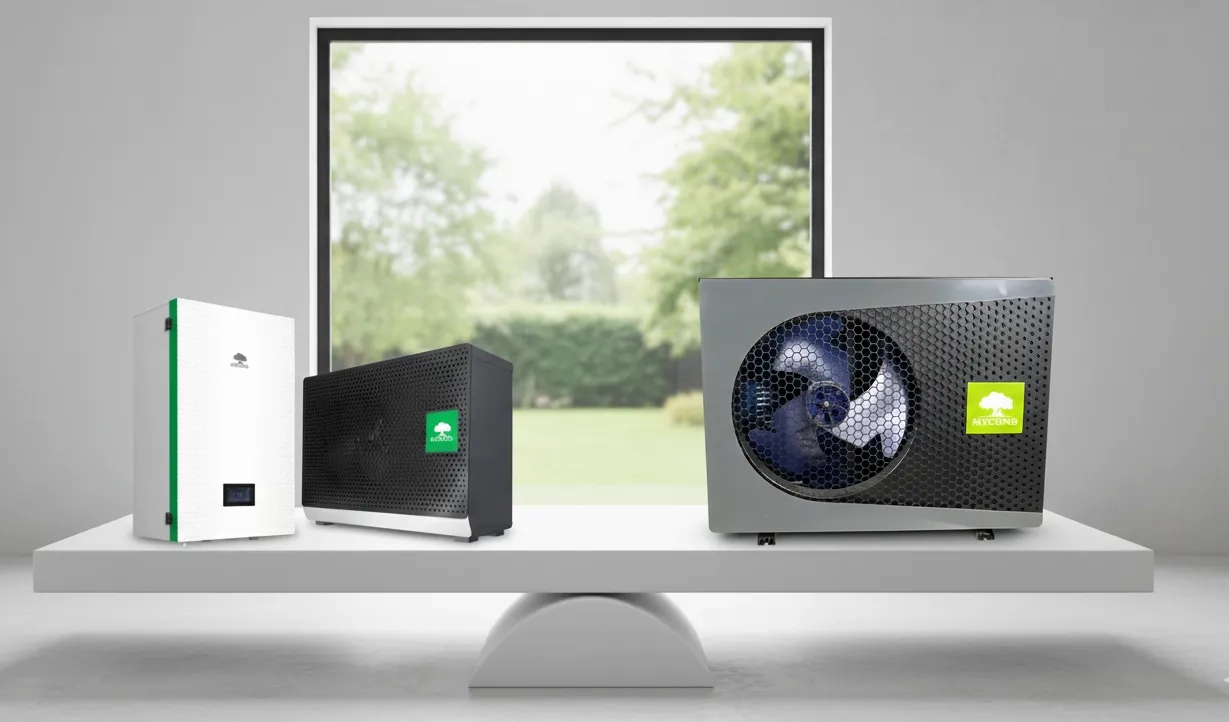
Monoblock — simpler installation, no refrigerant inside the house. Split — higher efficiency, flexible placement. The choice depends on your priorities.
When choosing an air-to-water heat pump, homeowners often face a dilemma: monoblock or split system? This is one of the key questions that determines not only the installation process but also the long-term operation of the heating system. It is important to understand that both types of heat pumps have their place and successfully deliver energy-efficient heating and cooling.
Your choice should be based not on popularity or superficial reviews but on an objective analysis of each type’s features and their suitability for your specific conditions. In this article, we will take a detailed look at the technical differences between monoblocks and split systems using the Mycond heat pump lineup as examples to help you make an informed decision.
What Are a Monoblock and a Split System: Design Features
A monoblock heat pump is a compact solution where all system components (compressor, evaporator, condenser, hydraulics) are combined in a single outdoor unit. Only water pipes run from it into the house, carrying a ready heated or cooled heat transfer fluid. This can be compared to a classic water heater located outside the house that supplies hot water inside.
Mycond monoblock solutions include the BeeThermic, MBasic, and BeeEco series. For example, the Mycond BeeThermic is equipped with a Panasonic EVI compressor, which ensures stable operation even at temperatures down to -25°C.
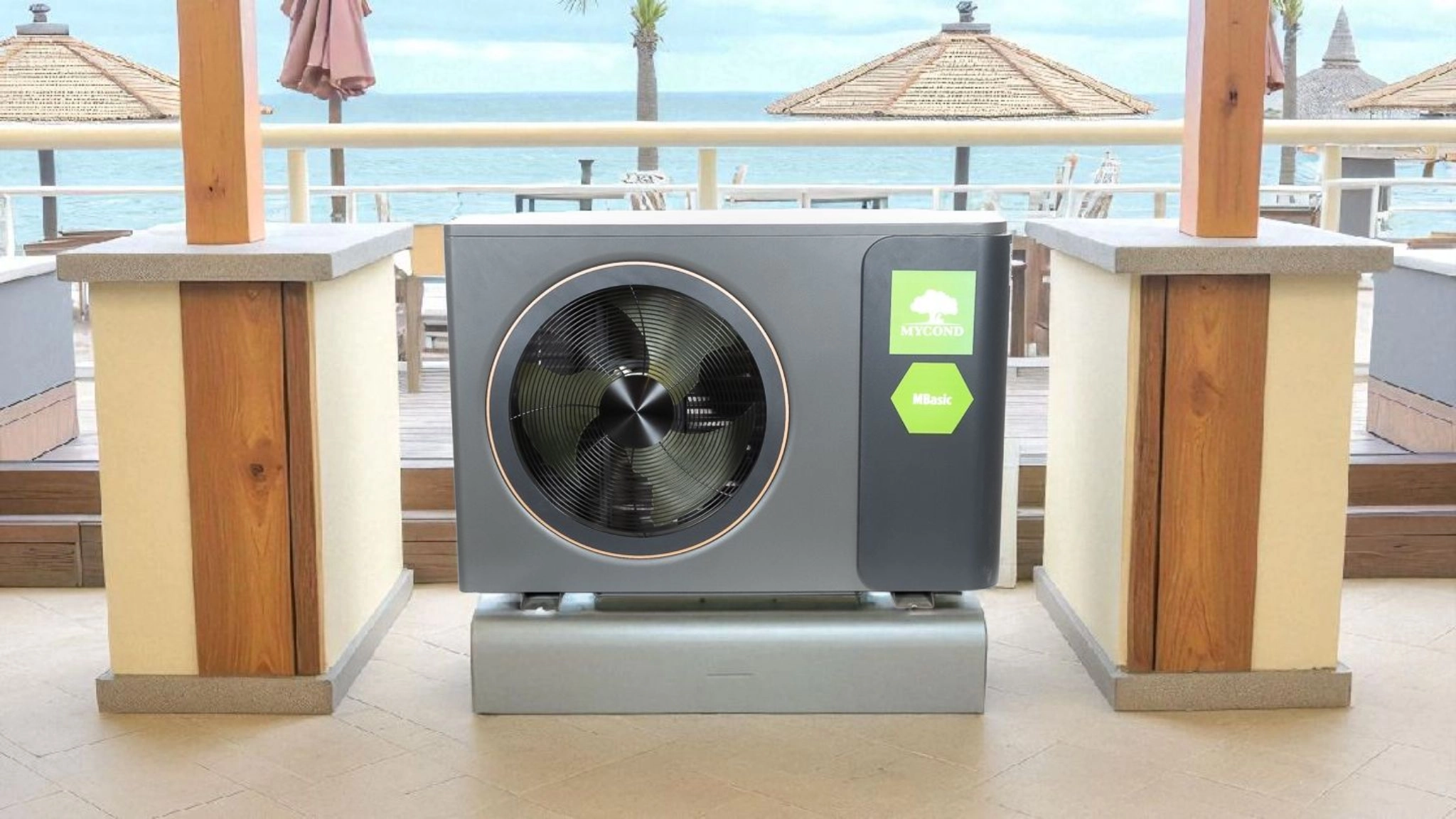
A split-system heat pump consists of two main units: the outdoor unit (housing the compressor and evaporator) and the indoor unit (a hydraulic module with a condenser). Refrigerant circulates between these units through refrigerant lines. A useful analogy is a conventional air conditioner, but instead of cooling air, the system heats water for space heating.
In the Mycond lineup, split systems are represented by the BeeHeat and BeeSmart series. BeeSmart, for example, comes with a Mitsubishi Electric inverter compressor and operates on R32 refrigerant, which has a low global warming potential.
How Each Type Works: Cycle and Features
The operating cycle of a heat pump is based on the thermodynamic principles of refrigerant compression and expansion. In a split system, this process is distributed between two units: the refrigerant absorbs thermal energy from the ambient air in the outdoor unit, then travels through the refrigerant line to the indoor unit, where it transfers this energy to the heating system’s heat transfer fluid.
In a monoblock, the entire cycle takes place within a single outdoor enclosure. The refrigerant never leaves the module, and the heated heat transfer fluid (water or antifreeze) is delivered directly to the home’s heating system through insulated pipes. This design simplifies installation but requires high-quality pipe insulation to minimize heat losses.
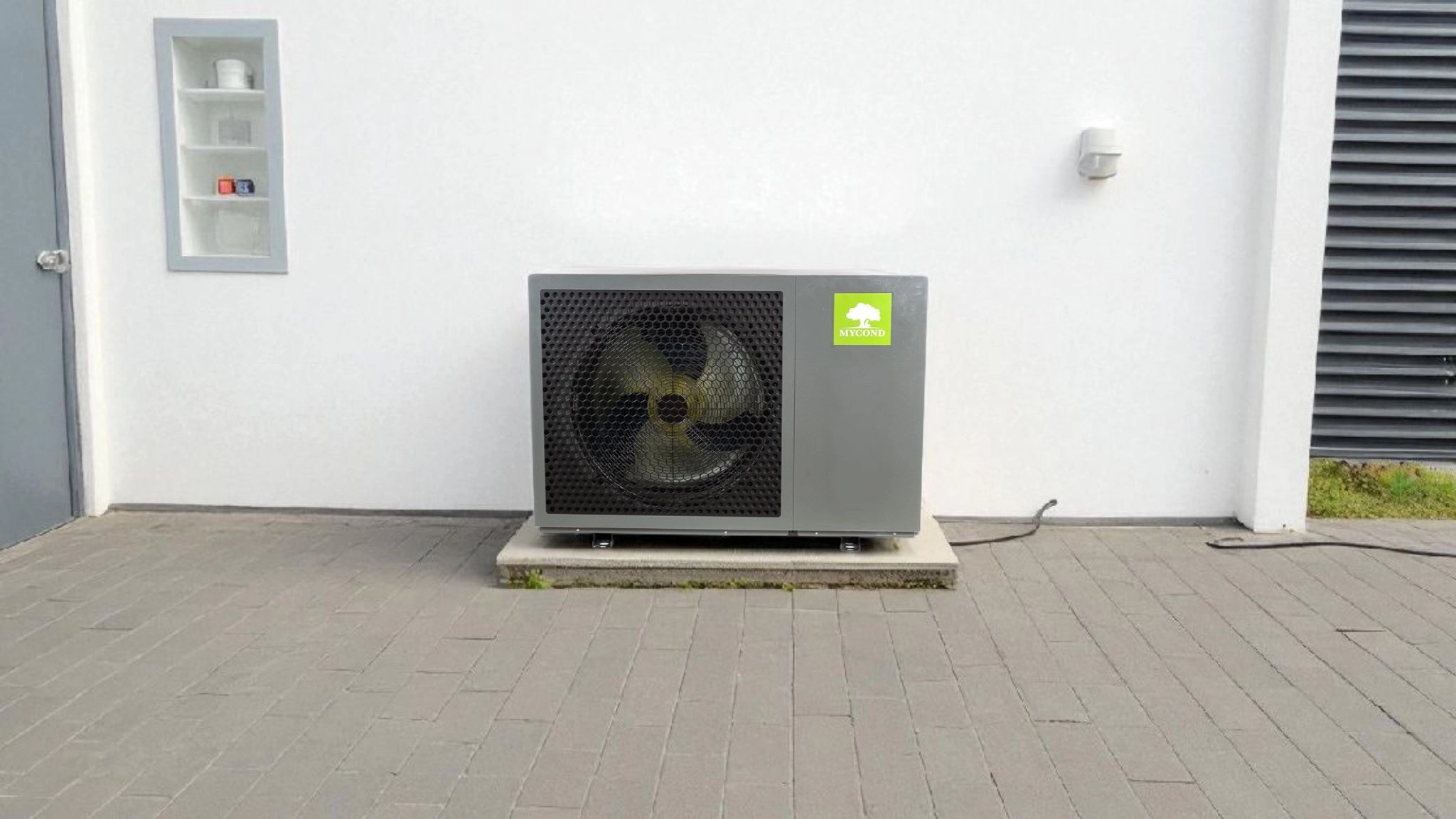
Installation: Complexity, Requirements, Licensing
The installation process is one of the key differences between heat pump types and often affects the homeowner’s choice.
Monoblock installation is simpler and more accessible. You don’t need a certified specialist for refrigerant handling because the refrigerant circuit is hermetically sealed at the factory. The procedure involves only standard plumbing work: connecting the water pipes to the home’s heating system, electrical connection, and automation setup.
Mycond BeeThermic, MBasic, and BeeEco models are equipped with G1" or G1¼" pipe connections, which are standard for most heating systems. An important advantage is that the circulation pump and expansion tank are already built into the unit, simplifying installation and saving space in the technical room.
Split-system installation requires more complex work related to the refrigerant circuit. The process includes installing two separate units, laying the refrigerant line between them, vacuuming the system, charging the refrigerant, and leak testing. These operations must be performed by certified specialists authorized to work with refrigerants — a requirement in most EU countries.
Mycond BeeHeat and BeeSmart split systems use R32 refrigerant and are equipped with Mitsubishi compressors. The indoor hydraulic module has a built-in circulation pump, which simplifies integration with the heating system.
It is important to understand that the greater installation complexity of split systems is not a disadvantage — it is simply a design characteristic that enables other benefits, such as greater flexibility in component placement.
Refrigerant in the House: Safety, Volume, Risks
The presence of refrigerant in living spaces is one of the decisive factors when choosing a heat pump type for many homeowners, especially families with children or people with heightened environmental awareness.
In monoblock heat pumps, the refrigerant is completely isolated in the outdoor unit and never enters the house. This minimizes risks associated with potential refrigerant leaks in living areas. This is especially relevant for the Mycond BeeEco model, which uses R290 (propane) — a natural, environmentally friendly, but flammable gas. Thanks to the monoblock design, this refrigerant always remains outside the house, making the system absolutely safe.
In split-system heat pumps, the refrigerant circulates between the outdoor and indoor units through refrigerant lines, part of which pass through the walls and are located inside the premises. Mycond BeeSmart and BeeHeat models use R32 refrigerant, which has a low global warming potential (GWP), but still requires proper system sealing.
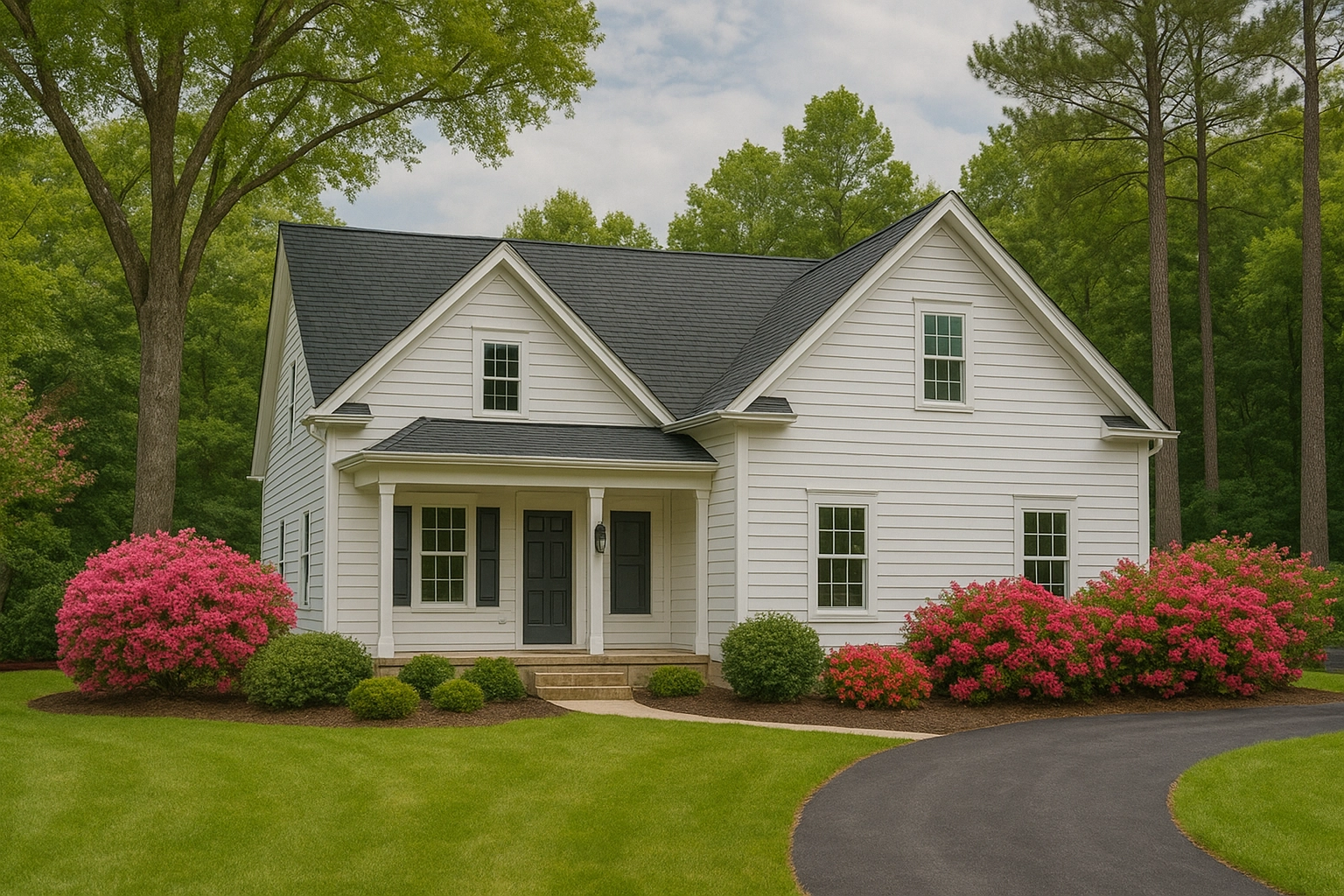
Modern split systems are equipped with numerous sensors and protective mechanisms that respond instantly to the slightest pressure deviations that may indicate a loss of tightness. In addition, professional installation significantly reduces leak risks. However, the very fact of having refrigerant inside the house is a factor worth considering when making your choice.
It is important to understand that modern refrigerants (especially R32 used in Mycond split systems) are significantly safer than their predecessors and, with proper installation and maintenance, pose virtually no threat. Nevertheless, the monoblock design still provides an additional level of safety and peace of mind for homeowners.
Reliability and Maintenance
Uptime and ease of maintenance are important factors when choosing a heat pump type, as this is a long-term investment for 15–20 years.
Monoblock heat pumps have an advantage due to fewer joints and components that can potentially fail. Since all elements of the system are in one housing, this reduces the risk of refrigerant circuit leaks. Maintenance is also simplified because all components are concentrated in one place and accessible to a technician.
Mycond BeeThermic models are equipped with reliable Panasonic EVI compressors, while MBasic uses Zhuhai Landa compressors, both of which have proven stable operation in various climatic conditions.
Split-system heat pumps have more connections, especially in the refrigerant circuit, which theoretically creates more potential failure points. However, with quality installation by certified specialists, the reliability of these systems is on par with monoblocks.
Mycond BeeHeat and BeeSmart split systems are equipped with Mitsubishi inverter compressors, renowned for their durability and efficient operation. A properly installed split system can operate for decades without major issues.
Efficiency: COP, SCOP, Performance at Low Temperatures
Energy efficiency is one of the most important parameters for assessing the long-term cost-effectiveness of a heat pump. Let’s look at key metrics and compare different Mycond heat pump series.
| Series | Type | SCOP (W35) | COP (A7/W35) | Min. operating temp | Energy efficiency class | Compressor |
|---|---|---|---|---|---|---|
| BeeSmart | Split | 4.72-4.98 | - | -25°C | A+++ | Mitsubishi |
| BeeHeat | Split | - | - | -25°C | - | Mitsubishi |
| BeeThermic | Monoblock | 3.23-4.58 | - | -25°C | A+++/A++ | Panasonic EVI |
| MBasic | Monoblock | 4.50-4.65 | 4.0-4.3 | -25°C | A+++ | Zhuhai Landa |
| BeeEco | Monoblock | - | up to 4.85 | -25°C | A+++ | - |
According to the technical datasheets, Mycond split systems, especially BeeSmart, demonstrate the highest seasonal coefficient of performance (SCOP) — from 4.72 to 4.98. This means that for every kilowatt of electricity consumed, the system produces up to 4.98 kW of thermal energy over the season.
Monoblocks also show high efficiency. MBasic has a SCOP of 4.50–4.65, and BeeEco achieves a COP of up to 4.85. The BeeThermic model with a Panasonic EVI compressor shows slightly lower SCOP values (3.23–4.58) but excels at extremely low temperatures thanks to the EVI (Economized Vapor Injection) technology.
In general, split systems often demonstrate higher SCOP due to lower losses in the hydraulic circuit, as the heat exchanger is located directly inside the house. Monoblocks have no refrigerant line between units but may lose some efficiency through heat losses in the water pipes between the unit and the house.
At temperatures below -20°C, models with EVI technology, such as BeeThermic, deliver better performance, making them an optimal choice for regions with harsh winters.
When to Choose a Monoblock: Scenarios and Use Cases
A monoblock heat pump becomes the optimal solution in many specific situations. Here are the main scenarios when you should favor this type of system:
- Retrofitting an existing heating system — if you are replacing a gas or solid-fuel boiler, a monoblock is easier to integrate into the existing system without significant rework. For example, BeeThermic is ideal for replacing a gas boiler thanks to a high supply temperature of up to +65°C.
- Limited installation budget or lack of certified refrigerant specialists — a monoblock can be installed by any qualified plumber, reducing installation costs.
- Desire to minimize the presence of refrigerant in the house — for families with children, safety-conscious users, or allergy sufferers, a monoblock provides extra peace of mind, as all refrigerant remains outside.
- Sites requiring fast installation — a monoblock can be installed literally in one day, which is critical for projects with tight timelines.
- Need for high supply temperatures — the BeeEco model provides a heat transfer fluid temperature of up to +75°C, enabling use with traditional radiator systems without modernization.
Typical applications: BeeThermic is excellent for replacing gas boilers in radiator systems, MBasic is an optimal solution for small houses with underfloor heating, and BeeEco is the perfect choice for systems with high-temperature radiators.
When to Choose a Split System: Scenarios and Use Cases
Split-system heat pumps have unique advantages that make them the optimal solution in certain situations:
- New builds with the ability to plan equipment placement — at the design stage, you can plan optimal refrigerant line routing and unit placement.
- Limited space for the outdoor unit — the outdoor unit of a split system is more compact than a monoblock of similar capacity, which is important for small lots.
- Maximum energy efficiency — for passive houses or sites with high demands for electricity savings, Mycond BeeSmart split systems with SCOP up to 4.98 deliver the highest return per kilowatt of electricity consumed.
- Cascaded systems for large facilities — BeeSmart supports combining up to 9 units in a cascade, allowing the creation of powerful systems for commercial sites or large residential complexes.
- Availability of qualified installers experienced with refrigerant systems — if there are certified specialists in your area, installation quality will be high.
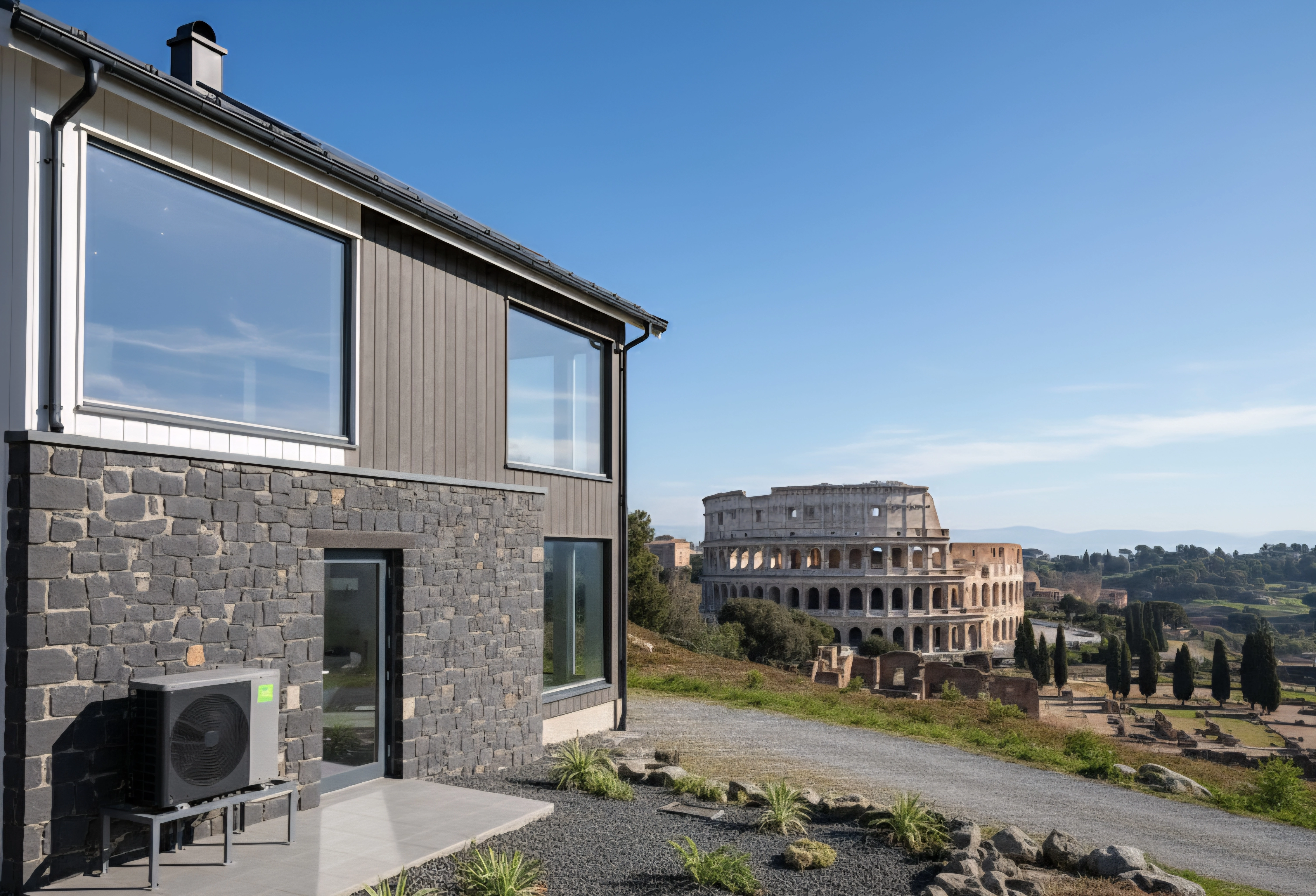
BeeHeat is ideal for energy-efficient homes with low-temperature heating systems such as underfloor heating or fan coils. BeeSmart is the optimal solution for projects requiring advanced control, monitoring, and integration with smart home systems.
Operation and Service: Annual Maintenance
Proper maintenance of a heat pump is the key to its long and efficient operation. Although different system types have particular maintenance features, the core procedures are similar:
For monoblocks:
- Annual check of pressure in the hydraulic circuit
- Cleaning the air heat exchanger from dust and leaves
- Inspection and cleaning of the water filter
- Check electrical connections
- Check antifreeze (if used)
For split systems:
- All of the above, plus regular refrigerant pressure checks
- Leak tightness control of refrigerant lines
- Check the operation of the indoor unit
Monoblock systems are somewhat simpler to maintain due to fewer components and the absence of refrigerant joints that require regular inspection. However, both types of heat pumps require preventive inspection at least once a year, preferably before the heating season begins.
All Mycond models have a self-diagnosis function that reports potential problems before they escalate, helping you plan maintenance in advance.
Cost: Upfront Investment and Operation
The financial aspect of choosing between a monoblock and a split system includes several important nuances to consider when budgeting.
Upfront investment:
- Monoblocks usually have a slightly higher equipment price but lower installation costs, as they do not require work with refrigerant lines.
- Split systems may cost less as equipment, but their installation requires certified specialists, increasing the overall project cost.
As a result, total initial expenses often turn out to be similar for both system types of the same capacity, but the cost structure differs.
Operating costs:
The main factor determining the cost-effectiveness of a heat pump is its seasonal coefficient of performance (SCOP). Higher SCOP values mean lower electricity consumption to achieve the same heating level.
According to technical data, Mycond BeeSmart split systems have the highest SCOP (up to 4.98), which theoretically makes them the most economical to operate. However, the MBasic and BeeEco monoblocks also demonstrate high efficiency (SCOP 4.50–4.65 and COP up to 4.85, respectively).
It is important to understand that real-world savings depend not only on the system type but also on the specific model, installation quality, home insulation, and usage patterns.
Comparison Table: Monoblock vs Split
| Criterion | Monoblock | Split System |
|---|---|---|
| Installation complexity | Simpler installation, standard plumbing work | More complex installation, certified specialist required |
| Refrigerant in the house | None, entire circuit outside | Present in lines between units |
| Placement flexibility | Limited, larger outdoor unit | High, compact outdoor unit |
| SCOP efficiency | 3.23-4.85 | 4.72-4.98 |
| Reliability | High, fewer connections | High with quality installation |
| Maintenance | Simpler, all components in one place | More complex, regular check of the refrigerant circuit |
| Installation cost | Lower | Higher |
| Maximum supply temperature | Up to +75°C (BeeEco) | Up to +55°C |
| Mycond series examples | BeeThermic, MBasic, BeeEco | BeeHeat, BeeSmart |
Common Mistakes When Choosing
When choosing between a monoblock and a split system, homeowners often make typical mistakes that may lead to extra costs or suboptimal system operation:
- Ignoring the qualification of available installers — choosing a split system in a region without certified refrigerant specialists can lead to poor installation and operating problems.
- Underestimating the factor of refrigerant presence in the house — especially important for families with children, people with allergies, or those with heightened environmental awareness.
- Choosing based solely on equipment price — without considering installation costs, which can significantly change the overall budget.
- Not accounting for supply temperature requirements — radiator heating often needs a higher heat transfer fluid temperature than underfloor heating, which affects model choice.
- Overlooking the size of the outdoor unit — a monoblock may be too large for limited outdoor space.
FAQ
Can I install a monoblock heat pump myself?
In theory, monoblock installation is simpler because it does not require work with the refrigerant circuit. However, to ensure warranty coverage and optimal operation, we recommend hiring qualified specialists experienced in integrating heat pumps with heating systems.
How much refrigerant is in a split system, and is it dangerous?
The amount of refrigerant depends on system capacity and line length. Mycond BeeHeat and BeeSmart residential systems use R32 refrigerant, which has a low global warming potential and low toxicity. With correct installation and regular maintenance, the risk of leakage is minimal.
Which type of heat pump is more economical to run?
Cost-effectiveness is determined primarily by the SCOP, not the system type. According to technical data, Mycond BeeSmart split systems have the highest SCOP (up to 4.98), but monoblocks also demonstrate high efficiency. The difference in real operating costs is usually small when comparing systems of a similar class.
Can I switch from a monoblock to a split system later?
Technically possible, but economically impractical. It essentially means a full system replacement with new installation. It is recommended to choose the optimal heat pump type for your conditions from the start.
What is the difference in noise level between a monoblock and a split system?
The main noise sources in a heat pump are the compressor and the outdoor unit fan. In a split system, the indoor unit operates almost silently, while a monoblock generates all noise outdoors. Modern Mycond models of both types have low noise levels thanks to quality compressor compartment soundproofing and inverter technology.
Does the type of heat pump affect service life?
With quality installation and regular maintenance, both types have a similar service life — 15–20 years. The key factors for longevity are component quality, correct installation, and regular maintenance.
What if there are no refrigerant technicians in my region?
In that case, a monoblock becomes the optimal choice, as qualified plumbers can install it without specific knowledge of refrigerant systems.
Conclusion
The choice between a monoblock heat pump and a split system is not about “better or worse,” but about finding the optimal option for your home’s specific conditions. Both technologies have their advantages and features that may be decisive depending on your priorities.
The monoblock offers simpler installation, no refrigerant inside the house, and often a higher maximum heat transfer fluid temperature. The split system provides higher energy efficiency, flexible placement, and a more compact outdoor unit.
The Mycond heat pump lineup offers high-quality solutions of both types — from the BeeThermic, MBasic, and BeeEco monoblocks to the BeeHeat and BeeSmart split systems — allowing you to choose the ideal option for any conditions.
Not sure which type of heat pump is right for you? Our Mycond engineers will help determine the optimal solution based on your home’s characteristics, budget, and climate conditions. Leave a request for a free consultation — we will call within an hour and answer all your questions.